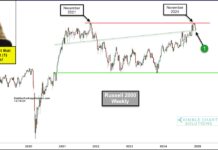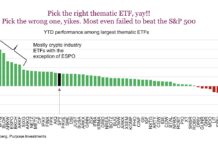What follows is a series of updates on the waterfall decline in the stock market and financial markets.
Each individual is veteran analyst or strategist with Baird.
Brian Skorney, Senior Research Analyst – Biotechnology:
For the major Western nations, the direct effects of the coronavirus outbreak are just beginning to be felt. Italy has been the canary in the coal mine for the U.S., UK, France and Spain, with each of those countries 1-2 weeks behind. In the U.S., there are major outbreaks in NY and Washington.
We continue to expect this initial surge to be the most significant headwind going forward as sick patients (with coronavirus or with other health problems) no longer get cared for. This has been the situation in Northern Italy for the last week.
There continues to be a lot we don’t know about this virus, and that ambiguity creates risk.
We are learning more every day, but I continue to think that the peak pain in the U.S. is somewhere between two and four weeks from now. There will be a big question as the situation improves, how long the efforts of social distances are maintained. I keep my eye on Italy in this respect too. Since they will likely see the impact subside ahead of us, they will also be the test to see when things get back to some level of normalcy. It is unlikely this will occur for them until the end of April, in our view. But if an attempt to pull back restrictions results is an escalation of infections and deaths, this would be a signal of a much longer duration problem.
Bruce Bittles, Chief Investment Strategist:
News that more people are testing positive for the coronavirus (as expected) has set into motion a waterfall decline in the U.S. equity markets. A waterfall decline is a stock market free fall with sudden drops of 20% or more compressed into a few short weeks. This includes sensational rebound rallies that typically don’t last more than a day and a half before the selling resumes.
These declines are fairly rare events and the current decline is following this pattern. These downturns generally last about 27 market days, and if this pattern holds true, would put us near the final phase of such a decline. Additionally, to be convinced that the market is in a bottoming process and momentum is returning to the upside we need to see strong broad market improvement that would include two days where advancing volume exceeds declining volume by a ratio of 10-to-1 or more.
The stock market is a forward-looking mechanism and does not move in lock step with the economy. For example, the economy was in a recession in 2009 and yet the S&P 500 closed the year up 32%. The equity market is a leading indicator of the economy and is likely to anticipate the peak in the spread of the virus and be headed higher before the news hits the headlines.
Willie Delwiche, Investment Strategist:
The ultimate severity of this cyclical decline remains to be determined. We can acknowledge the uniqueness of the current circumstances but also be aware what happens after periods of intense selling. Most often, initial lows are followed by rallies and re-tests.
The final low comes as pessimism is rampant, expectations for earnings and the economy are reduced and positive divergences emerge beneath the surface. The rallies off of those final lows tend to see overwhelmingly broad participation and this helps create self-sustaining upside momentum. The process of making initial lows can be jarring, but it is unwise to let panic overwhelm perspective. Reconsiderations of risk tolerance, if necessary, are best done after the downside intensity has ebbed.
Prior to evidence that the rally and re-test stage of the decline has run its course, sector exposure should be tilted toward defensive areas of the market. Health Care and Consumer Staples are areas that have shown relative leadership in recent weeks and we expect that to continue for now. As we gain confidence that re-tests have been successful, cash that has accumulated on the sidelines can be put to work in cyclical area of the market.
Global diversification remains critical as the timing and intensity of any rebounds could vary by region. On average, stocks have bottomed four months prior to the end of recessions and a new cyclical bull market is usually well underway by the time the headlines notice improving economic conditions. Looking beyond the headlines, even in the face of so much near-term uncertainty, has helped keep investors on a long-term path of success.
B. Craig Elder, PWM Fixed Income Analyst:
Bond markets have been extremely volatile, making it very hard to trade as uncertainty about economic outcomes results in reluctance from traders to bid bonds. Simply said, nobody wants to buy bonds – especially to hold in inventory. We have seen the 10-year Treasury fall in intraday trading to .030% last week to 1.20%. The current level is 1.04%. In addition, we have seen T-bill rates fall into negative yield territory with the 2-month bill falling to -0.05%.
Municipal bond yields, traditionally thought to have value when they trade at 85% of the yield of a comparable maturity Treasury issue, have been trading at 150%-300% over Treasuries as the municipal bond market yields have risen significantly (i.e., 10-year municipal paper trading in the 2.40% area). Mutual fund managers are selling shorter-maturity debt because they are the easiest to sell when they are raising cash to pay for fund liquidations. On a brighter note, there is talk that Congress may require the Fed to purchase municipal bonds as part of their asset purchase program
Investment-grade corporate bond spreads are wider out to 2.85% to yield 4.06% (duration is 7.55) while U.S. high-yield debt (junk bonds) spreads are out to 904 bps (were less than 400 bps a month ago) to yield 10.124% (duration is 4.67 as junk bonds are normally issued with maturities of 10-years or less). Problems in high yield began earlier as falling oil and gas prices began to drive bond prices down (and yields up) before covid-19 became a pandemic issue.
Bottom line: The global spread of the coronavirus has had an unprecedented toll on our lives, the economy, and the financial markets. Our combined perspectives can help navigate periods of uncertainty and volatility. We are all in this together.
Twitter: @WillieDelwiche
Any opinions expressed herein are solely those of the author, and do not in any way represent the views or opinions of any other person or entity.








